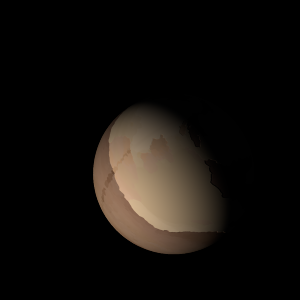|
|
Space Astro
|
Info for exoplanet "Hepaato"
| Scientific (actual) data |
|---|
| Name | Kepler-1129 c |
| Planet status | Confirmed |
| Radius | 0.244 |
| Orbital period | 76.537 |
| Discovered | 2016 |
| Updated | 2021-02-05 |
| Tconj | 2455000 |
| Publication | Announced on a website |
| Detection type | Primary Transit |
| Alternate names | 2MASS J19262507+4118336 c, K02167.03, KIC 6041734 c, KOI-2167 c, KOI-2167.03, WISE J192625.06+411833.6 c |
| Star name | Kepler-1129 |
| Right ascension | 291.6° |
| Declination | 41.31° |
| Mag j | 14.173 |
| Mag h | 13.804 |
| Mag k | 13.783 |
| Star distance | 1258 |
| Star metallicity | -0.04 |
| Star mass | 1 |
| Star radius | 1 |
| Star age | 4.07 |
| Star temperature | 5831 |
| Star alternate names | 2MASS J19262507+4118336, KIC 6041734, KOI-2167, WISE J192625.06+411833.6 |
| Wikipedia article | Kepler-1129 c |
Back
| |
| Fictional info (?) |
|---|
| Suggested name | Hepaato |
| Planet type | Cold planet |
|
| Estimated population | 50000000000 |
| Atmosphere | Oxygen | 70% |
| Carbon dioxide | 26% |
| Water | 3% |
| Methane | 0.0011% |
| Atmospheric pressure | 0.9 bar |
 |
| No known satellites |
| Google search for Hepaato |
|
Website by Joachim Michaelis
|
|
|
|